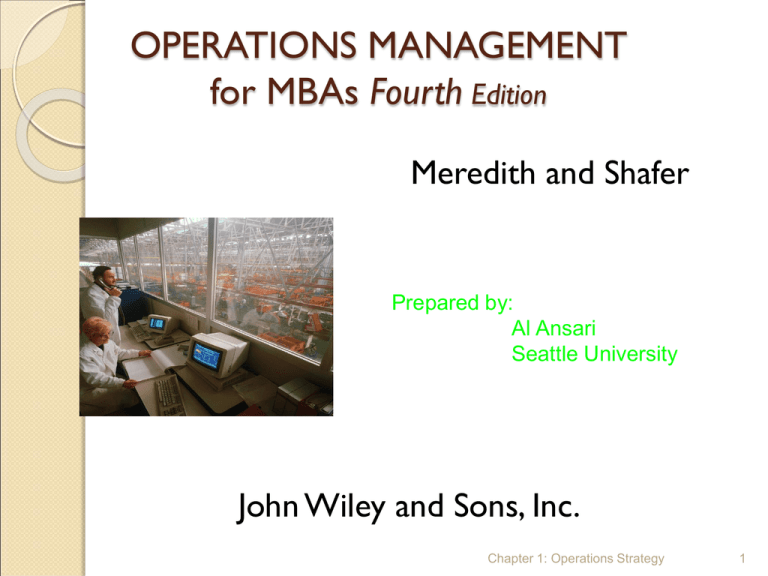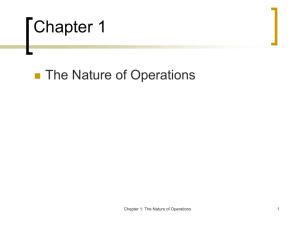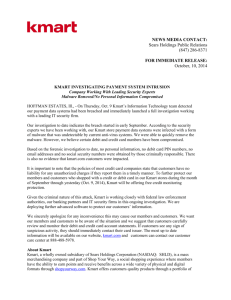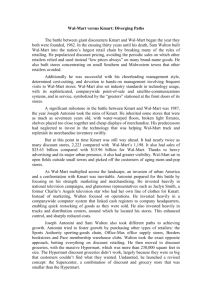
OPERATIONS MANAGEMENT
for MBAs Fourth Edition
Meredith and Shafer
Prepared by:
Al Ansari
Seattle University
John Wiley and Sons, Inc.
Chapter 1: Operations Strategy
1
Chapter 1
Operations Strategy
and
Global Competitiveness
Chapter 1: Operations Strategy
2
Introduction
Chapter 1: Operations Strategy
3
McDonald’s Corp
Facing Increased Competition
Smarter and More Demanding Customers
Less Brand Loyal
Switched to hamburger bun that does not
require toasting.
Customers prefer taste of new bun
Saves time and money
Chapter 1: Operations Strategy
4
Olympic Flame
10,000 runners
15,000 miles through 42
states in 84 days
Two years of planning
Must plan for no-show
runners and rush hour
traffic
Cost of this operation in
the neighborhood of $20
million
Chapter 1: Operations Strategy
5
Kmart Versus Wal-Mart
Both chains started in 1962
In 1987, Kmart had 2,223 stores to WalMart’s 1,198.
Kmart’s sales were $25.63 billion to WalMart’s $15.96 billion
By 1991, Wal-Mart’s sales exceeded Kmarts
Kmart still had more stores
Chapter 1: Operations Strategy
6
Kmart Versus Wal-Mart continue
In year ending January 1996, Wal-Mart’s
sales were $93.6 billion to Kmart’s $34.6
billion.
During this time Kmart emphasized
marketing and merchandising (such as
national TV ad campaigns).
Wal-Mart was investing millions in its
operations to lower cost.
Chapter 1: Operations Strategy
7
Kmart Versus Wal-Mart continue
Wal-Mart developed sophisticated distribution
system that integrated its computer system
with its distribution system.
Kmart’s employees lacked skills needed to plan
and control inventory.
Period from 1987 to 1995 Kmart's market
share declined from 34.5 percent to 22.7
percent.
Wal-Mart's increased from 20.1 percent to 41.6
percent
Chapter 1: Operations Strategy
8
Kmart Versus Wal-Mart continue
Fast forward to 2004
◦ Kmart appears to have adopted a new
strategy
Merge with Sears, Roebuck & Co.
◦ Potential synergies between Kmart’s
convenient locations and Sears’ strong brands
Chapter 1: Operations Strategy
9
General Motors
Highly competitive automobile Industry
Market share eroding
Rebate strategy
Weakness in product offerings (8 brands)
Toyota (2 brands)
Long lead time to redesign
What is a sustainable market share?
Chapter 1: Operations Strategy
10
Flat Panel TVs
Large profit margins ($8 billion 2004)
Asian manufacturers (LG Electronics and
Royal Philips, Sony and Samsung, and
Matsushita)
North America’s Dell
Chapter 1: Operations Strategy
11
Operations
Heart of every organization
Operations are the tasks that create value
Chapter 1: Operations Strategy
12
Diversity and Importance
of Operations
Improvements in operations can
simultaneously lower costs and improve
customer satisfaction.
Improving operations often dependent on
advances in technology.
Can obtain competitive advantage by
improving operations.
Diversity of Operations
Chapter 1: Operations Strategy
13
The Production System
Chapter 1: Operations Strategy
14
Systems Perspective
Inputs
Transformation System
◦
◦
◦
◦
Alter
Transport
Store
Inspect
Outputs
Environment
Chapter 1: Operations Strategy
15
Inputs
Inputs include facilities, labor, capital, equipment,
raw materials, and supplies.
A less obvious input is knowledge of how to
transform the inputs into outputs.
The operations function quite frequently fails in
its task because it cannot complete the
transformation activities within the required
time limit.
Chapter 1: Operations Strategy
16
Transformation System
The part of the system that adds value to
the inputs.
Four major ways
◦
◦
◦
◦
Alter
Transport
Store
Inspect
Chapter 1: Operations Strategy
17
Outputs
Two types of outputs commonly result
from a production system
◦ Services (physical goods)
◦ Products (abstract or nonphysical)
Chapter 1: Operations Strategy
18
Chapter 1: Operations Strategy
19
Facilitating Good Concept
Often confusion in trying to classify
organization as manufacturer or service
Facilitating good concept avoids this
ambiguity
All organizations defined as service
The tangible part of the service is defined
as facilitating good
Pure Services
Chapter 1: Operations Strategy
20
The Range From Services
to Products
Chapter 1: Operations Strategy
21
Chapter 1: Operations Strategy
22
Operations Activities
Strategy
Output Planning
Capacity Planning
Facility Location
Facility Layout
Aggregate Planning
Inventory
Management
Materials
Requirements
Planning
Scheduling
Quality Control
Chapter 1: Operations Strategy
23
Defining and Measuring Quality
Conformance to specifications
Performance
Quick response
Quick-change expertise
Features
Reliability
Durability
Serviceability
Aesthetics
Perceived quality
Humanity
Value
Chapter 1: Operations Strategy
24
Mass Customization
Seek to produce low-cost, high-quality
outputs in high variety.
Not all products lend themselves to being
customized (Ex. Sugar, gas, electricity, and
flour).
Is applicable to products characterized by
short life cycles, rapidly advancing
technology, or changing customer
requirements.
Chapter 1: Operations Strategy
25
Chapter 1: Operations Strategy
26
Four Mass Customization Strategies
Collaborative customizers
Adaptive customizers
Cosmetic customizers
Transparent customizers
Chapter 1: Operations Strategy
27
Collaborative Customizers
These organizations establish a dialogue to help
customers articulate their needs and then develop
customized outputs to meet these needs. For
example, one Japanese eyewear retailer developed a
computerized system to help customers select
eyewear. The system combines a digital image of the
customer's face and then various styles of eyeware
are displayed on the digital image. Once the
customer is satisfied, the customized glasses are
produced at the retail store within an hour.
Chapter 1: Operations Strategy
28
Adaptive Customizers
These organizations offer a standard
product that customers can modify
themselves such as closet organizers. Each
closet-organizer package is the same, but
includes instructions and tools to cut the
shelving and clothes rods so that the unit
can fit a wide variety of closet sizes.
Chapter 1: Operations Strategy
29
Cosmetic Customizers
These organizations produce a standard
product but present it differently to different
customers. For example, Planters packages
its peanuts and mixed nuts in a variety of
containers on the basis of specific needs of
its retailing customers such as Wal-Mart, 7Eleven, and Safeway.
Chapter 1: Operations Strategy
30
Transparent Customizers
These organizations provide custom
products without the customers’ knowing
that a product has been customized for
them. For example, Amazon.com provides
book recommendations based on
information about past purchases.
Chapter 1: Operations Strategy
31
Dependability and Speed
The competitive advantages of faster, dependable
response to new markets or to the individual
customer's needs have only recently been noted in
the business media.
Americans spend more time and money on
marketing, whereas the Japanese spend five times
more than the Americans on developing more
efficient production methods.
Chapter 1: Operations Strategy
32
Relationship Between Response
Time and Unit Cost
Chapter 1: Operations Strategy
33
Strategy
Chapter 1: Operations Strategy
34
Core Competencies
Collective knowledge and skills an organization
has that distinguish it from the competition.
Typically center on an organization’s ability to
integrate a variety of specific technologies and
skills in the development of new products and
services.
Building blocks of core capabilities.
Chapter 1: Operations Strategy
35
Core Competencies continue
Are basis on which new outputs are
developed.
Better to think of organization in terms of its
portfolio of core competencies than as a
portfolio of products.
Identifying and developing core competencies
is one of top management’s most important
roles.
Organization practices and business processes
Chapter 1: Operations Strategy
36
Examples of Core Competencies
Sony - miniaturization
3M- knowledge of substrates, coatings
and adhesives
Black and Decker - small electrical
motors and industrial design
Honda - engines and power trains
Chapter 1: Operations Strategy
37
Vision and Mission Statements
Vision
statements used to
express organization’s values and
aspirations.
Mission statements express
organization’s purpose or reason
for existence.
Chapter 1: Operations Strategy
38
Strategic Frameworks
Chapter 1: Operations Strategy
39
The Life-Cycle Curve
Chapter 1: Operations Strategy
40
Product Life Cycle
Strategies often tied to product life cycle
Length of life cycles shrinking
Business strategy should match life cycles
stages
Chapter 1: Operations Strategy
41
Categories of Business
Strategies
Chapter 1: Operations Strategy
42
First-to-Market Strategy
Products available before competition
Strong applied research capability needed
Can set high price to skim market or set
lower price to gain market share
Chapter 1: Operations Strategy
43
Second-to-Market Strategy
Quick imitation of first-to-market
companies
Less emphasis on applied research and
more emphasis on development
Learn from first-to-market’s mistakes
Chapter 1: Operations Strategy
44
Cost Minimization or Late-toMarket Strategy
Wait until market becomes standardized and
large volumes demanded
Compete on basis of costs instead of
product features
Research efforts focus on process
development versus product development
Chapter 1: Operations Strategy
45
Market Segmentation
Serving niche markets
Applied engineering skills and flexible
manufacturing processes needed
Chapter 1: Operations Strategy
46
Example Performance Frontier
Chapter 1: Operations Strategy
47
New Technology Results in
Shift of Performance Frontier
Chapter 1: Operations Strategy
48
Focus
Stressing one key business value .
the key value at Hewlett-Packard is
developing new products
Sticking to what the know best. Define
core capabilities (strengths) and then
build on them.
Chapter 1: Operations Strategy
49
Key Characteristics of Core
Competencies/Capabilities
Should be used to gain access to a variety
of markets
Should be strongly related to key benefits
provides by products or services
Should be difficult to imitate
Chapter 1: Operations Strategy
50
Order Qualifiers and Winners
Order qualifiers are
characteristics that
are the ante to enter
the market
Order winners are
characteristics that
win the customer’s
purchase
Chapter 1: Operations Strategy
51
Product Life Cycle Stages
and Emphasis
Chapter 1: Operations Strategy
52
The Sand Cone Model
Chapter 1: Operations Strategy
53
Reasons to Produce Offshore
Circumvent governmental regulations
Avoid effects of currency fluctuations
Avoid fees and quotas
Placate local customers
Chapter 1: Operations Strategy
54
Outsourcing
Subcontracting out production of parts or
performance of activities
Activities and parts fall on a continuum
ranging from strategically unimportant to
strategically important
Activities not strategically important are
candidates to be outsourced
Chapter 1: Operations Strategy
55
Hollowed Out
The extent that most of a firm’s complex
parts and production are outsourced
Often when complex parts outsourced,
engineering talent follows
Supplier may become competitor
Chapter 1: Operations Strategy
56
Copyright
Copyright 2010 John Wiley & Sons, Inc. All rights reserved.
Reproduction or translation of this work beyond that named in
Section 117 of the United States Copyright Act without the express
written consent of the copyright owner is unlawful. Requests for
further information should be addressed to the Permissions
Department, John Wiley & Sons, Inc. Adopters of the textbook are
granted permission to make back-up copies for their own use only, to
make copies for distribution to students of the course the textbook is
used in, and to modify this material to best suit their instructional
needs. Under no circumstances can copies be made for resale. The
Publisher assumes no responsibility for errors, omissions, or damages,
caused by the use of these programs or from the use of the
information contained herein.
Chapter 1: Operations Strategy
57












![HEB Market Analysis[1]](http://s2.studylib.net/store/data/005485404_1-54cabf3bf07d6c92d73f2b15077d5f55-300x300.png)